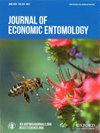Parasitism by Gryon aetherium (Hymenoptera: Scelionidae) on Bagrada hilaris (Hemiptera: Pentatomidae) eggs in northcentral California.
IF 2.2
2区 农林科学
Q1 ENTOMOLOGY
引用次数: 0
Abstract
Bagrada bug, Bagrada hilaris (Burmeister) (Hemiptera: Pentatomidae), is an invasive pest of cruciferous crops. The parasitoid Gryon aetheriumTalamas (Hymenoptera: Scelionidae) is a promising biological control agent for B. hilaris because it can forage in the soil where B. hilaris deposits most of its eggs. In this study, we assessed parasitism by G. aetherium on B. hilaris eggs in situ in northcentral California, including the Salinas Valley where most cruciferous crops in the United States are grown. Parasitism was documented by leaving soil-filled trays under infested plants for 7–14 days, then removing eggs and holding them for emergence of parasitoids. Gryon aetherium accounted for over 99% of emerged parasitoids, and occurred at 11 of the 12 sampled sites. Of the 17,729 and 31,759 B. hilaris eggs collected in 2021 and 2022, 1,518 (8.84%) and 2,654 (8.36%) were parasitized by G. aetherium, respectively. Parasitism rates were generally higher inland and ranged from 3.64% to 44.93% in 2021 and from 1.01% to 23.04% in 2022, and never exceeded 15% on any sample dates at several coastal sites in the Salinas Valley. Discovery efficiency (a measure of the ability of parasitoids to locate egg patches) reached 80% or higher at all but 1 site, but exploitation efficiency (a measure of the ability of parasitoids to exploit the egg patch after it has been discovered) was generally <20%, suggesting that G. aetherium can locate egg patches efficiently but is less efficient at finding eggs within patches.Gryon aetherium对加利福尼亚州中北部的门蛙(半翅目:Pentatomicae)卵的寄生(膜翅目:Scelionidae)。
Bagrada虫是十字花科作物的入侵性害虫。类寄生蜂Gryon aetherium Talamas(膜翅目:Scelionidae)是一种很有前途的肺吸虫生物防治剂,因为它可以在肺吸虫大部分卵子沉积的土壤中觅食。在这项研究中,我们在加利福尼亚州中北部,包括美国大多数十字花科作物生长的萨利纳斯山谷,原位评估了G.aetherium对B.hilaris卵的寄生作用。通过将装满土壤的托盘放在受感染的植物下7-14天,然后取出鸡蛋并将其保存以等待寄生蜂的出现,从而记录了寄生现象。Gryon aetherium占出现的寄生蜂的99%以上,发生在12个采样点中的11个。在2021年和2022年采集的17729个和31759个肺门乳杆菌卵中,分别有1518个(8.84%)和2654个(8.36%)被毛滴虫寄生。内陆地区的寄生虫感染率普遍较高,2021年为3.64%至44.93%,2022年为1.01%至23.04%,在萨利纳斯山谷的几个沿海地区的任何采样日期都从未超过15%。发现效率(衡量寄生蜂定位卵斑的能力)在除1个地点外的所有地点都达到80%或更高,但利用效率(衡量发现卵斑后寄生蜂利用卵斑的可能性)通常
本文章由计算机程序翻译,如有差异,请以英文原文为准。
求助全文
约1分钟内获得全文
求助全文
来源期刊
CiteScore
4.60
自引率
9.10%
发文量
198
审稿时长
3-6 weeks
期刊介绍:
Journal of Economic Entomology the most-cited entomological journal – publishes articles on the economic significance of insects and other arthropods and includes sections on apiculture & social insects, insecticides, biological control, household & structural insects, crop protection, forest entomology, and more. In addition to research papers, Journal of Economic Entomology publishes Reviews, interpretive articles in a Forum section, Short Communications, and Letters to the Editor. The journal is published bimonthly in February, April, June, August, October, and December.

 求助内容:
求助内容: 应助结果提醒方式:
应助结果提醒方式:


